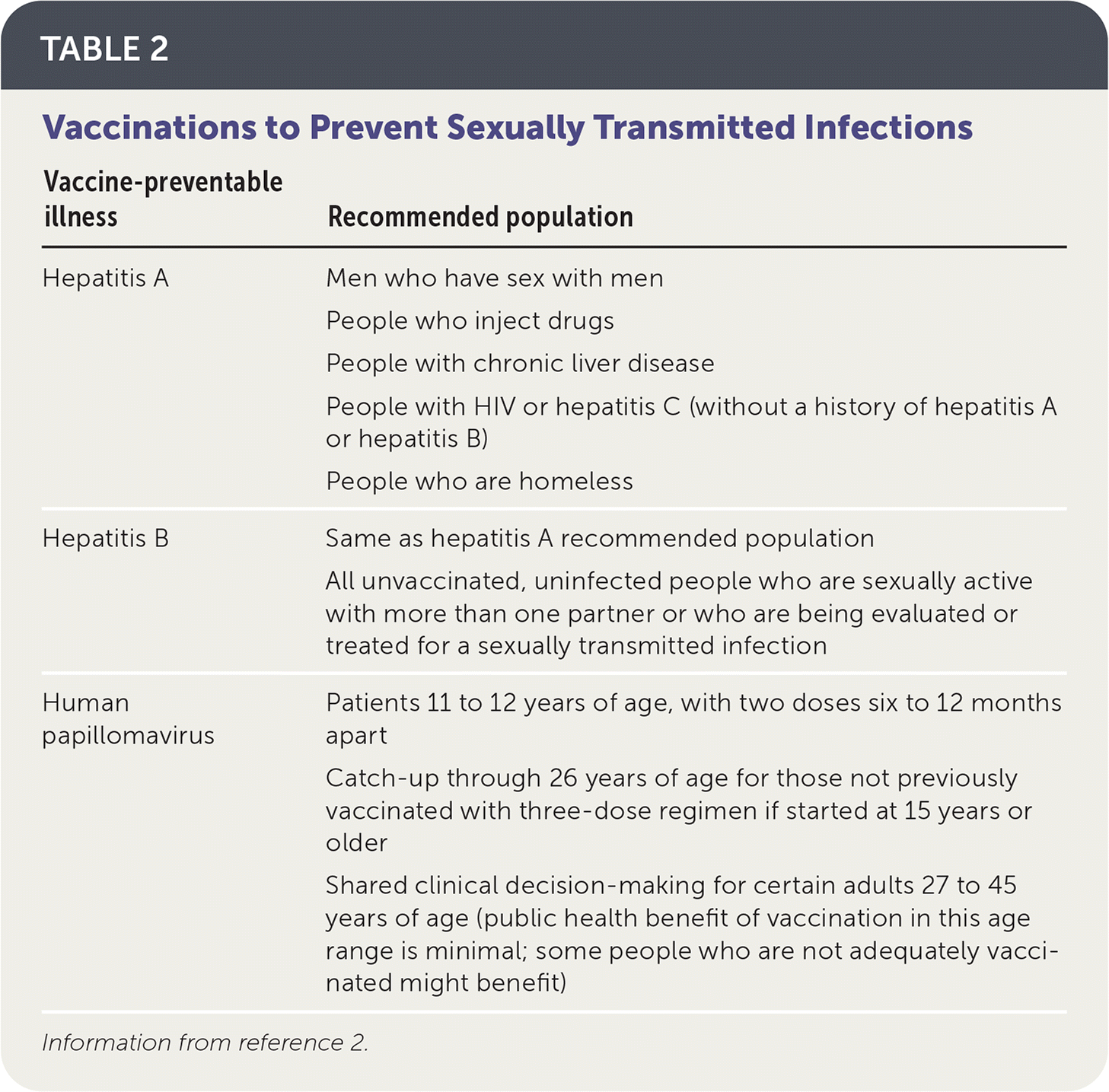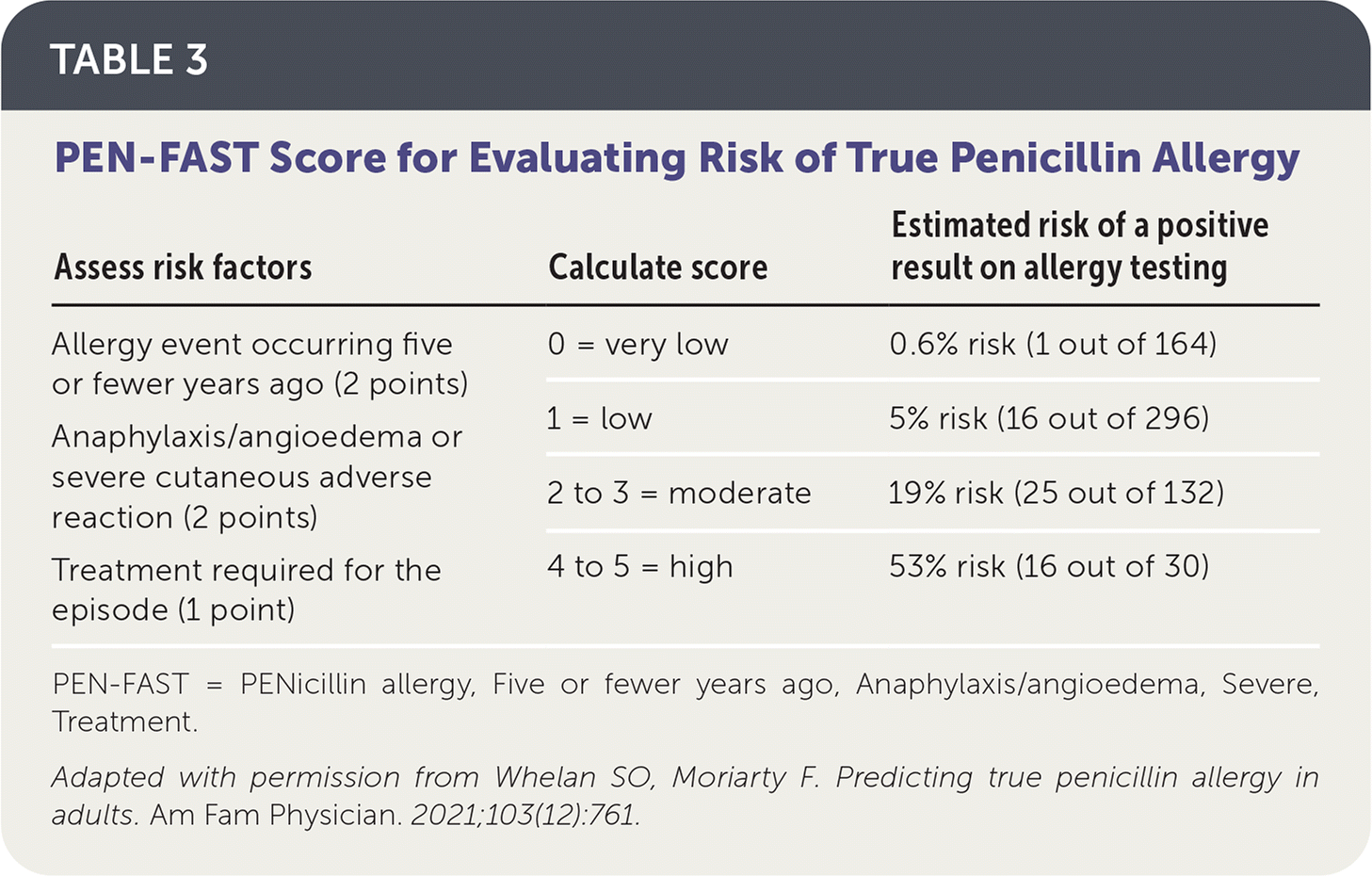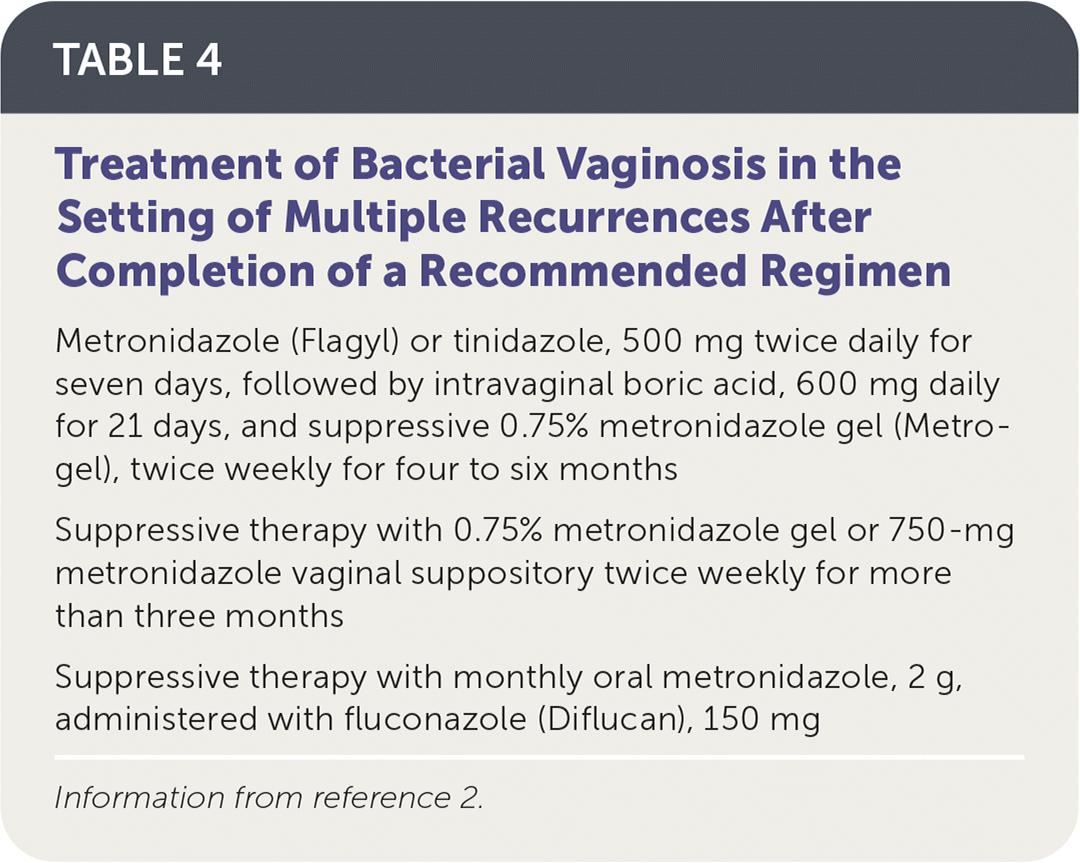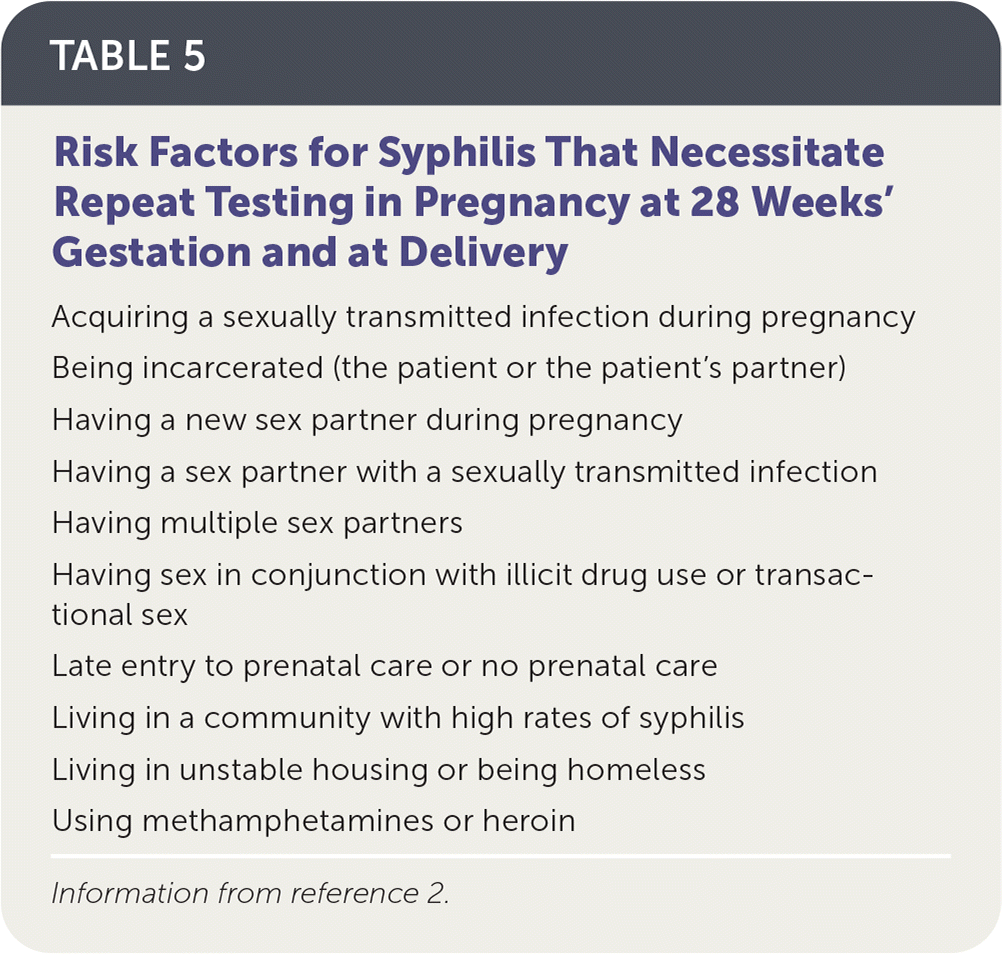
Am Fam Physician. 2022;105(5):514-520
Related practice guideline: Sexually Transmitted Infections: Updated Guideline From the CDC
Related editorial: Neurosyphilis, Ocular Syphilis, and Otosyphilis: Detection and Treatment
Author disclosure: No relevant financial relationships.
Sexually transmitted infection (STI) rates are increasing for most nationally notifiable disease categories in the United States. The 2021 Centers for Disease Control and Prevention STI guidelines provide several updated, evidence-based testing and treatment recommendations. The recommended treatment for gonorrhea is ceftriaxone monotherapy given intramuscularly, with dosing based on the patient's body weight. For chlamydia, doxycycline is the preferred treatment. A test-of-cure is recommended for all cases of pharyngeal gonorrhea and for rectal chlamydia if treated with azithromycin. Vaginal trichomoniasis should be treated with a seven-day regimen of metronidazole. Treatment of pelvic inflammatory disease routinely includes metronidazole with doxycycline and an increased dosage of ceftriaxone. Syphilis of less than one year's duration should be treated with a single dose of intramuscular penicillin G benzathine, 2.4 million units. Syphilis of more than one year's or unknown duration should be treated with three consecutive weekly doses of intramuscular penicillin G benzathine, 2.4 million units each. A thorough evaluation for otic, ophthalmic, and neurologic symptoms is essential for anyone with syphilis because these complications can occur at any stage and require 10 to 14 days of treatment with intravenous aqueous crystalline penicillin G. Family physicians can reduce STI rates by taking a thorough sexual history, especially in teens and young adults, ordering screening tests and treatment based on the updated Centers for Disease Control and Prevention STI guidelines, and collaborating with public health departments for disease reporting and partner services.
From 2014 to 2019, U.S. rates of sexually transmitted infections (STIs) increased for chlamydia (19%), gonorrhea (56%), primary and secondary syphilis (74%), and congenital syphilis (279%).1 The combined epidemics of STIs and opioid use, compounded by reduced screening and treatment opportunities during the COVID-19 pandemic, will likely further exacerbate this trend. Family physicians can reduce infection rates by discussing sexual history, especially with teens and young adults, ordering screening tests and treatment based on the 2021 Centers for Disease Control and Prevention (CDC) STI treatment guidelines (Table 12), and collaborating with public health departments for disease reporting and partner services.

| Factor | Recommendation updates |
|---|---|
| Asymptomatic extragenital (rectum, pharynx) infection | Perform rectal Chlamydia trachomatis NAAT testing in MSM, consider in women at risk |
| If rectal C. trachomatis infection is treated with azithromycin (Zithromax), perform test-of-cure | |
| Perform routine test-of-cure 14 days after treatment of pharyngeal gonorrhea | |
| Perform rectal and oropharyngeal gonorrhea NAAT in MSM, consider in women at risk | |
| Epididymitis | Cover for enteric pathogens if patient reports having insertive rectal intercourse |
| Consider Mycoplasma genitalium in cases of persistent epididymitis | |
| Expedited partner therapy | For partners of patients with gonorrhea, increase cefixime (Suprax) dose to 800 mg orally |
| Hepatitis | Offer preexposure vaccination for hepatitis A and hepatitis B (Table 2) |
| Perform serologic testing for hepatitis B after vaccination in people starting PrEP | |
| Screen for hepatitis C in all pregnant patients (unless prevalence is known to be < 0.1%) and yearly for those on PrEP | |
| HPV | Offer patients routine vaccination through 26 years of age and shared decision-making for those 27 to 45 years of age |
| Perform digital anorectal examination in people with HIV infection and possibly in MSM without HIV who have a history of receptive anal intercourse | |
| Pelvic inflammatory disease | Routinely treat with 14 days of metronidazole (Flagyl), 500 mg twice per day; 14 days of doxycycline, 100 mg twice per day; and intramuscular ceftriaxone at increased weight-based dosing to cover gonorrhea |
| Proctitis | Treat empirically with ceftriaxone, 500 mg, plus doxycycline, 100 mg twice per day for seven days |
| For proctocolitis, consider treating lymphogranuloma venereum with doxycycline, 100 mg twice per day for 21 days | |
| For fever and diarrhea, perform enteropathogen testing | |
| Ulcerative disease | |
| HSV | Type-specific polymerase chain reaction testing of a lesion is preferred over culture for herpes diagnosis |
| Perform two-step serologic testing when used to diagnose genital herpes | |
| Syphilis | Screen pregnant patients in high-incidence areas and those with risk factors at the time of pregnancy diagnosis, at 28 weeks' gestation, and at delivery |
| Urethritis/cervicitis | |
| Chlamydia (C. trachomatis) | Treat with doxycycline, 100 mg twice per day for seven days (preferred regimen) |
| Gonorrhea | Provide monotherapy with a single intramuscular dose of ceftriaxone, 500 mg in patients weighing less than 300 lb (136 kg) or 1,000 mg in patients weighing more than 300 lb |
| M. genitalium | Testing should be performed only for symptomatic patients with persistent urethritis or cervicitis; testing can be considered in pelvic inflammatory disease and in persistent epididymitis, but it should not be performed for vaginal discharge alone |
| If M. genitalium is macrolide-resistant or sensitivity testing is not available, treat with doxycycline, 100 mg twice per day for seven days, followed by moxifloxacin (Avelox), 400 mg daily for seven days | |
| If M. genitalium is macrolide-sensitive, treat with doxycycline, 100 mg twice per day for seven days, followed by azithromycin, 1 g on day 1 and 500 mg on days 2 through 4 | |
| Nongonococcal urethritis | Provide doxycycline, 100 mg twice per day for seven days (first-line treatment) |
| Consider screening patients with persistent or recurrent non-gonococcal urethritis for Trichomonas vaginalis and M. genitalium | |
| Vaginitis | |
| Bacterial vaginosis | Be aware that bacterial vaginosis increases the risk of STI acquisition, including HIV |
| Do not screen asymptomatic pregnant patients | |
| Candida | For recurrent vulvovaginal candidiasis with more than three episodes per year, consider weekly fluconazole (Diflucan) for six months |
| T. vaginalis | Consider testing asymptomatic patients at high risk or in high-prevalence settings |
| Treat vaginal trichomoniasis with metronidazole, 500 mg twice per day for seven days |
Prevention
Taking a thorough sexual history using gender-inclusive and sexual orientation–inclusive language can improve rapport, ensure appropriate screening of all sites of exposure, and allow for a focused and patient-specific discussion of risk reduction. Include the Five P's—partners, practices, protection from STIs, past STIs, and pregnancy intention— in the discussion.3 The U.S. Preventive Services Task Force recommends behavioral counseling with a focus on condom use and decreasing sexual risk behaviors.4 Physicians should encourage vaccination against hepatitis A, hepatitis B, and human papillomavirus, as recommended for age and additional risk factors such as sexual acts that risk fecal–oral and blood-borne exposure (Table 2).2

| Vaccine-preventable illness | Recommended population |
|---|---|
| Hepatitis A | Men who have sex with men |
| People who inject drugs | |
| People with chronic liver disease | |
| People with HIV or hepatitis C (without a history of hepatitis A or hepatitis B) | |
| People who are homeless | |
| Hepatitis B | Same as hepatitis A recommended population |
| All unvaccinated, uninfected people who are sexually active with more than one partner or who are being evaluated or treated for a sexually transmitted infection | |
| Human papillomavirus | Patients 11 to 12 years of age, with two doses six to 12 months apart |
| Catch-up through 26 years of age for those not previously vaccinated with three-dose regimen if started at 15 years or older | |
| Shared clinical decision-making for certain adults 27 to 45 years of age (public health benefit of vaccination in this age range is minimal; some people who are not adequately vaccinated might benefit) |
HIV preexposure prophylaxis (PrEP) with emtricitabine and tenofovir alafenamide (Descovy; for those with a creatinine clearance of 30 mL per minute per 1.73 m2 [0.50 mL per second per m2] or more, not at risk of vaginal HIV exposure) or emtricitabine and tenofovir disoproxil fumarate (Truvada; creatinine clearance of 60 mL per minute per 1.73 m2 [1.00 mL per second per m2] or more) is safe and effective. The U.S. Preventive Services Task Force recommends offering PrEP to individuals at risk, including those who have had gonorrhea or syphilis during the previous six months, those who share drug injection equipment, those who are HIV-negative but whose sex partner has HIV infection, and those with inconsistent use of condoms during receptive or insertive anal sex.5
Expedited partner therapy, the provision of medication to sex partners of people with STIs without examination or testing of the partner, has been shown to reduce the spread of infection at the community level and prevent reinfection of the index case.6,7 The American Academy of Family Physicians advocates for the use of expedited partner therapy whenever possible to help address increasing rates of STIs. 8 Cefixime (Suprax), with a dosing increase to 800 mg, is the recommended expedited partner therapy regimen for gonorrhea (Table 12), with the addition of doxycycline, 100 mg twice daily for seven days, if concurrent chlamydia has not been excluded. There are no changes to the recommended expedited partner therapy regimen for chlamydial infection (i.e., 1 g of azithromycin [Zithromax] in a single oral dose or 100 mg of doxycycline given twice daily for seven days).
ANTIBIOTIC STEWARDSHIP
The new guidelines highlight antibiotic stewardship in addressing patient-reported penicillin allergy.2 Although as many as 10% of patients report a penicillin allergy, 90% of those patients tolerate penicillins when allergy tested.9 Physicians should carefully define allergies, separating those with reactions mediated by immunoglobulin E (IgE) from those experiencing common adverse effects. The PEN-FAST rule is a validated clinical tool to guide risk assessment and treatment decisions (Table 3).9 Physicians should use ceftriaxone and penicillins when risk of true allergy is low and consider penicillin allergy testing for those with possible allergy to preserve treatment options.

| Assess risk factors | Calculate score | Estimated risk of a positive result on allergy testing |
|---|---|---|
| Allergy event occurring five or fewer years ago (2 points) | 0 = very low | 0.6% risk (1 out of 164) |
| Anaphylaxis/angioedema or severe cutaneous adverse reaction (2 points) | 1 = low | 5% risk (16 out of 296) |
| 2 to 3 = moderate | 19% risk (25 out of 132) | |
| Treatment required for the episode (1 point) | 4 to 5 = high | 53% risk (16 out of 30) |
Urethritis and Cervicitis
Urethritis is characterized by dysuria, urethral pruritus or burning, and/or visible discharge. Neisseria gonorrhoeae and Chlamydia trachomatis are the most common causes, but Mycoplasma genitalium is increasingly recognized as an important cause of urethritis, particularly in patients presumptively treated for chlamydial infection with persistent symptoms.10 Patients with suspected urethritis should be evaluated for gonorrhea and chlamydia using nucleic acid amplification testing, and patients with persistent symptoms should be tested for M. genitalium infection.2,11 Other causative organisms, including Neisseria meningitidis and Trichomonas vaginalis, have also been implicated in urethritis.
Patients with cervicitis are often asymptomatic; vaginal discharge is variable, and clinical examination may reveal mucopurulent cervical discharge, hyperemia, ectopy, or friability. C. trachomatis and N. gonorrhoeae are the most common etiologies. Untreated infection can progress to the upper genital tract, causing pelvic inflammatory disease.
Ceftriaxone monotherapy is now recommended as the treatment of choice for gonorrhea (Table 12). Previous CDC guidelines recommended routine dual-therapy regimens in an effort to stave off emerging drug resistance. However, new guidance reflects concerns for antimicrobial steward-ship and potential harm from overuse of antibiotics. Thus, co-treatment for gonorrhea with azithromycin or doxycycline is no longer recommended. Test-of-cure is not necessary for people with urogenital or rectal gonorrhea but is recommended 14 days after treatment for patients with pharyngeal infection.
Doxycycline has emerged as the treatment of choice for chlamydial infections (Table 12). Recent clinical trials and meta-analyses showed higher rates of microbiologic treatment failure among men and women treated with azithromycin compared with doxycycline.12–14 Azithromycin, 1 g in a single oral dose, remains an alternative regimen and is the recommended treatment for pregnant patients. It may also be considered for those with confidentiality concerns or those unable to adhere to seven-day regimens.
Patients diagnosed with M. genitalium should ideally be treated in a two-stage approach using resistance-guided therapy. Initial treatment with doxycycline reduces organism load and facilitates organism clearance, followed by either azithromycin if the M. genitalium isolate is macrolide-sensitive or moxifloxacin (Avelox) if the isolate is macrolide-resistant or if resistance testing is unavailable (Table 12).
Extragenital Infection
Chlamydia and gonorrhea are also causes of extragenital infection (e.g., rectum, pharynx).15,16 Pharyngeal gonorrhea is mostly asymptomatic, fairly common, and a major driver of community spread with the potential to increase antibiotic resistance. Several studies have shown markedly increased detection of infection with universal extragenital testing in sexually active patients.15,17 Rectal chlamydia is as common in cisgender women as in men who have sex with men, even in those who do not report receptive anal intercourse.18 Wider use of nucleic acid amplification testing to screen for asymptomatic rectal and pharyngeal infection is recommended, including the option of patient-collected specimens, which are reliable and have high patient acceptability.19,20
STIs involving the rectum can cause proctitis or proctocolitis, characterized by anorectal pain, tenesmus, rectal discharge, diarrhea, or abdominal cramping. The most commonly detected pathogens are N. gonorrhoeae, C. trachomatis, Treponema pallidum, and herpes simplex virus (HSV). Diagnosis is ideally achieved through anoscopy, with Gram stain smear of anorectal exudate and nucleic acid amplification testing for gonorrhea, chlamydia, and HSV and serology for syphilis. Recommended empiric treatment for acute proctitis is ceftriaxone and doxycycline (Table 12). If C. trachomatis is detected and the patient has severe symptoms suggestive of lymphogranuloma venereum (rectal ulcers, anal discharge, bleeding, tenesmus), doxycycline should be continued for 21 days. Further treatment should be directed toward specific pathogens that are identified.
Vaginitis
Vaginitis tops the list of gynecologic diagnoses in primary care.21 Bacterial vaginosis, a vaginal dysbiosis with a predominance of anaerobic bacteria replacing the Lactobacillus species, is the most common cause of vaginal discharge. Having bacterial vaginosis increases the risk of STI acquisition, including HIV 22; however, testing and treatment are recommended only for symptomatic patients.2,23 The U.S. Preventive Services Task Force recommends against routine screening of asymptomatic patients, including pregnant people not at risk for preterm delivery.23 Data are still limited for how to best address recurrent bacterial vaginosis. The new guidelines offer options for suppressive therapy with various regimens (Table 4).2

| Metronidazole (Flagyl) or tinidazole, 500 mg twice daily for seven days, followed by intravaginal boric acid, 600 mg daily for 21 days, and suppressive 0.75% metronidazole gel (Metrogel), twice weekly for four to six months |
| Suppressive therapy with 0.75% metronidazole gel or 750-mg metronidazole vaginal suppository twice weekly for more than three months |
| Suppressive therapy with monthly oral metronidazole, 2 g, administered with fluconazole (Diflucan), 150 mg |
Trichomoniasis, caused by Trichomonas vaginalis, is the most common nonviral STI; rates are highest in women 40 years and older.24,25 Vaginal infection is often asymptomatic and can last years. Physicians should test symptomatic patients with vaginal discharge at presentation and annually test asymptomatic women who have HIV. Also, physicians should consider testing asymptomatic patients in high-prevalence settings and those with risk factors for STI. Although wet mount is commonly used at low cost, it has low sensitivity.26,27 A negative result on wet mount should be confirmed with higher sensitivity molecular diagnostic testing. Vaginal infection is treated with a seven-day course of metronidazole (Flagyl), 500 mg twice per day, because this shows superior effectiveness compared with the previous single 2-g dose recommendation.28 Penile infection should be treated with a single 2-g dose of metronidazole. Partners should be referred for presumptive treatment with consideration of expedited partner therapy where permissible by law. Persistent trichomoniasis should be treated, after confirming no risk of reinfection, with increased daily dosing of 2-g metronidazole or tinidazole for seven days. For further persistence without reexposure risks, drug-resistance testing is recommended.
Ulcerative Disease
Genital herpes and syphilis are the primary causes of genital ulcers in at-risk sexually active patients in the United States.2 Both infections can also present as oral or perianal ulcers. Less common infectious causes include Haemophilus ducreyi (chancroid); C. trachomatis serovars L1, L2, and L3 (lymphogranuloma venereum); and Klebsiella granulomatis (granuloma inguinale [donovanosis]). A complete evaluation should include syphilis serology and HSV type–specific testing from the lesion. While awaiting test results, presumptive treatment of syphilis is important to reduce the risk of community transmission and of HSV to maximize effectiveness of therapy. The choice of presumptive therapy directed at syphilis or HSV should be guided by clinical presentation with consideration to syphilis incidence in the local population.
HSV-1 and -2 can cause anogenital ulceration. Confirming the type of HSV helps guide prognosis because HSV-1 presenting as genital lesions is less likely to recur. When collecting samples from a lesion, HSV nucleic acid amplification testing is more sensitive than culture, especially in the case of recurrent disease and healing lesions. HSV-2 antibody testing can aid in diagnosis when a clinical history is suspicious for genital herpes, but active lesions are not present, and it may be helpful to test and counsel partners of symptomatic patients with HSV-2.2
Syphilis rates continue to show an alarming upward trend. Although predominantly occurring in men who have sex with men, especially men of color younger than 30 years, an increased number of syphilis infections are occurring in women.1 With more infections in women of reproductive age, congenital syphilis rates are rising sharply.1 Physicians should test pregnant people with risk factors at intake, at 28 weeks' gestation, and at delivery (Table 5).2 Many laboratories have transitioned to “reverse sequence syphilis screening,” in which an automated treponemal antibody test (e.g., enzyme immunoassay) is performed first, followed by a nontreponemal test (rapid plasma reagin [RPR] or Venereal Disease Research Laboratory [VDRL] test) for confirmation. Advantages include the ability to perform high volume testing quickly, earlier detection in recent infection, and increased detection of latent infection.29 The risk of the reverse sequence algorithm is false-positive treponemal testing, especially in low-risk populations, that requires additional confirmation. Nontreponemal antibody titers (RPR/VDRL) decline over time and with treatment; thus, they are important for following treatment response and diagnosing reinfection. For patients with a history of previously treated syphilis infection, a fourfold increase in RPR or VDRL titer suggests reinfection and warrants repeat treatment. Treponemal antibodies, meanwhile, typically remain positive for life and are not helpful following initial diagnosis.

| Acquiring a sexually transmitted infection during pregnancy |
| Being incarcerated (the patient or the patient's partner) |
| Having a new sex partner during pregnancy |
| Having a sex partner with a sexually transmitted infection |
| Having multiple sex partners |
| Having sex in conjunction with illicit drug use or transactional sex |
| Late entry to prenatal care or no prenatal care |
| Living in a community with high rates of syphilis |
| Living in unstable housing or being homeless |
| Using methamphetamines or heroin |
Preferred treatment remains parenteral penicillin G benzathine, 2.4 million units, with a single intramuscular dose given for infection of less than one year's duration, whereas infection persisting more than one year or of unknown duration should be treated with three consecutive weekly doses of 2.4 million units each. Physicians should ensure that the correct formulation of penicillin G benzathine (Bicillin L-A) is given for intramuscular injection. Erroneous substitution of shorter-acting penicillin G benzathine/penicillin G procaine (Bicillin C-R) does not adequately treat syphilis. A thorough evaluation for otic, ophthalmic, and neurologic symptoms is essential for anyone with syphilis because these complications can occur at any stage and require 10 to 14 days of treatment with intravenous aqueous crystalline penicillin G.
Health System Considerations
The COVID-19 pandemic brought multiple challenges to health care systems, including temporary clinic closures and shortages of staff, medications, and diagnostic testing kits.30 These challenging times spurred innovations, such as telemedicine assessment and treatment of STI symptoms, patient-collected STI testing, and enhanced partnerships with pharmacies to provide injectable antibiotic treatment.30 Disease intervention specialists, long employed in STI care, have provided a foundation for COVID-19 contact tracing. Collaborating with local public health entities and complying with mandatory reporting programs are crucial to combat rising rates of STIs. Additional free resources for physicians include the CDC 2021 STI Tx mobile app, the STD Clinical Consultation Network (https://stdccn.org/), and CME with the National STD Curriculum (https://www.std.uw.edu/).
This article updates a previous article on this topic by Van Vranken.31
Data Sources: The primary source for this article was the 2021 Centers for Disease Control and Prevention STI Treatment Guidelines published July 23, 2021. A PubMed search was completed using the key terms sexually transmitted infections, extragenital, chlamydia, gonorrhea, and prenatal syphilis screening. Additional searches included Essential Evidence Plus, U.S. Preventive Services Task Force, and the Cochrane database. Search dates: April 2020; August 2021; and February 28, 2022.
